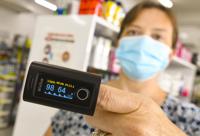
Pharmacist Krista Burgin demonstrates the function of a pulse oximeter at the Mega Drug Pharmacy’s outlet in Tamuning Tuesday.
In collaboration with the American Medical Center, the Guam Department of Education will be hosting a Covid-19 Vaccination Outreach on Sept. 18 from 10 a.m.-4 p.m. at the Tiyan High School gymnasium. This outreach is available to students 12 years or older. For information, email info@gdoe.net.
Pulse oximeters, which are important for monitoring the blood oxygen levels of people with COVID-19, became popular Monday afternoon after several island doctors, during a government press conference, reinforced the importance of owning one.
Guam Rexall Drugs, in Tamuning, reported selling all 24 of its pulse oximeters Monday afternoon, within an hour of the governor’s pandemic-related press conference.
“Generally, when you get infected with COVID, … at day six of exposure to COVID, you generally have symptoms of dyspnea — you feel short of breath. That’s generally about the time that patients start to get a little bit more concerned,” Dr. Joleen Aguon, medical director for Guam Memorial Hospital, said Monday.
“If you have ‘silent hypoxia,’ you don’t feel it. You have no idea that your oxygen levels are critically low in your tissues. So one of the (best pieces of) advice that I give for the community is, if you are testing positive for COVID, that you purchase a pulse oximeter,” she said.
“This pulse oximeter, at days five and on from your exposure, is something that needs to be checked several times during the day, because you will not know that your oxygen levels are that low,” she said.
A blood oxygen level less than 95% is cause for concern, according to Aguon, who said patients should seek hospital treatment.
Dr. Mike Cruz, state surgeon of the Guam Army National Guard, said some COVID-19 patients with low oxygen levels don’t experience shortness of breath, but instead report feeling fatigued.
“If you don’t have an O2 saturation or a pulse oximeter, get one, because by the time you think that you’re having shortness of breath, it may be too late,” Cruz said.
Low levels
According to Aguon and the Department of Public Health and Social Services, many of Guam’s recent COVID-19 deaths involved residents who were brought to hospitals dead on arrival, likely because they didn’t realize how dangerously little oxygen was in their blood.
Aguon said COVID-19 patients with low oxygen levels generally are admitted to the hospital about eight days after exposure. If their condition doesn’t improve, they are moved to the intensive care unit about 10 to 12 days after exposure, she said.
“We are seeing more deaths coming through our ER dead on arrival. That means our medics, our first-line responders, are called to the homes of people who have been found lifeless, and breathless — all COVID unvaccinated patients,” said Gov. Lou Leon Guerrero.
Although about 83% of Guam’s eligible population is now fully vaccinated for COVID-19, it is unclear at what point vaccines will stop the spread of the virus, according to the governor.
“I don’t think even the CDC people know what that number is,” the governor said. “I was listening to Dr. Anthony Fauci, and he himself said he didn’t know what that number was because every situation in every community is different.”
The governor said, because of the island’s high vaccination rate, “I feel that, yes, we will be able to turn this around and we will be able to stabilize it and contain it.”











(0) comments
Welcome to the discussion.
Log In
Keep it Clean. Please avoid obscene, vulgar, lewd, racist or sexually-oriented language.
PLEASE TURN OFF YOUR CAPS LOCK.
Don't Threaten. Threats of harming another person will not be tolerated.
Be Truthful. Don't knowingly lie about anyone or anything.
Be Nice. No racism, sexism or any sort of -ism that is degrading to another person.
Be Proactive. Use the 'Report' link on each comment to let us know of abusive posts.
Share with Us. We'd love to hear eyewitness accounts, the history behind an article.